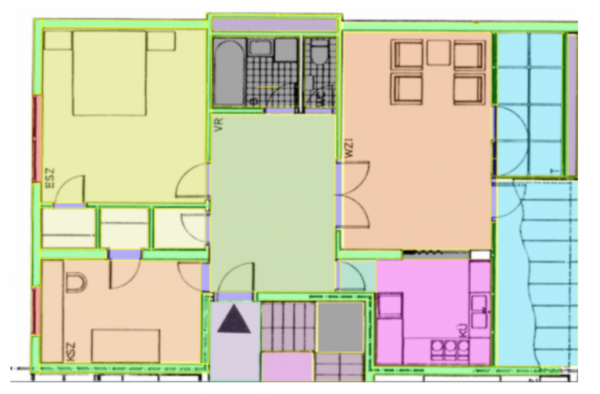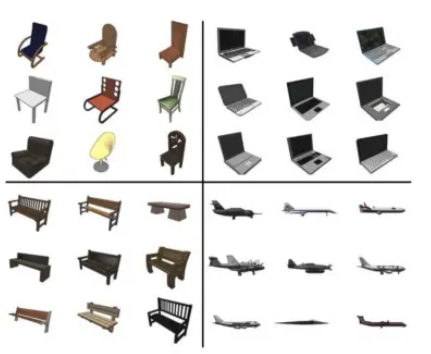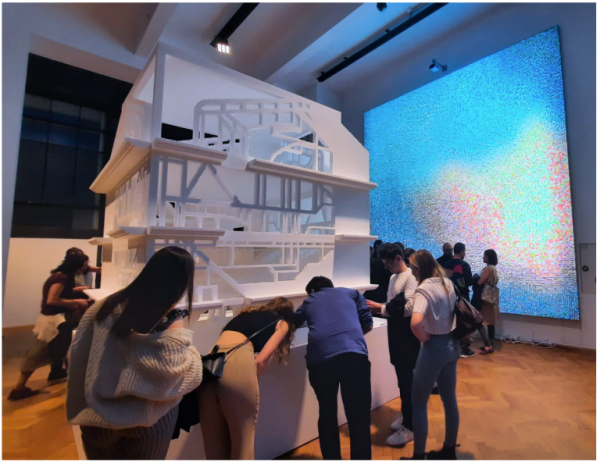There is a lot to consider when designing places where humans live and work. How will the space be used? Who’s using the space? What are budget considerations? It is painstaking and time consuming to develop all of those details into something usable.
What if Generative AI (GenAI) could help? We already know that it can be used to create text, music, and images. Did you know that it can also create building designs and floor plans?
Dr. Matias del Campo, associate professor of architecture in the Taubman College for Architecture and Urban Planning, has been working to make architectural generative models more robust. He aims to expand on the patterns, structures, and features from the available input data to create architectural works. Himself a registered architect, designer, and educator, del Campo conducts research on advanced design methods in architecture using artificial intelligence techniques.
He leverages something called neural networks for two projects:
- Common House: A project that focuses on floor plan analysis and generation.
- Model Mine: A large-scale, 3D model housing database for architecture design using Graph Convolutional Neural Networks and 3D Generative Adversarial Networks.


What exactly are neural networks? The name itself takes inspiration from the human brain and the way that biological neurons signal to one another. In the GenAI world, neural networks are a subset of machine learning and are at the heart of deep learning algorithms. This image of AI hierarchy may be helpful in understanding how they are connected.
Dr. del Campo’s research uses GenAI for every step of the design process including 2D models for things like floors and exteriors, and 3D models for shapes of the rooms, buildings, and volume of the room. The analysis informs design decisions.
DEI considerations
del Campo notes that there are some DEI implications for the tools he’s developing. “One of the observations that brought us to develop the ‘Common House’ (Plangenerator) project is that the existing apartment and house plan datasets are heavily biased towards European and U.S. housing. They do not contain plans from other regions of the world; thus, most cultures are underrepresented.”
To counterbalance that, del Campo and his team made a global data collection effort, collecting plans and having them labeled by local architects and architecture students. “This not only ensured a more diverse dataset but also increased the quality of the semantic information in the dataset.”
How technology supports del Campo’s work
A number of services from Information Technology & Services are used in these projects, including: Google at U-M collaboration tools, GenAI, Amazon Web Services at U-M (AWS), and GitHub at U-M.
Also from ITS, the Advanced Research Computing (ARC) team provides support to del Campo’s work.
“We requested allocations from the U-M Research Computing Package for high-performance computing (HPC) services in order to train two models. One focuses on the ‘Common House’ plan generator, and the other focuses on the ‘Model Mine’ dataset to create 3D models based,” said del Campo.

Additionally, they used HPC allocations from the UMRPC in the creation of a large-scale artwork called MOSAIC which consists of over 20,000 AI-generated images, organized in a color gradient.
“We used HPC to run the algorithm that organized the images. Due to the necessary high resolution of the image, this was only possible using HPC.”
“Dr. del Campo’s work is really novel, and it is different from the type of research that is usually processed on Great Lakes. I am impressed by the creative ways Dr. del Campo is applying ITS resources in a way that we did not think was possible,” said Brock Palen, director of the ITS Advanced Research Computing.
Related: Learn about The Architecture + Artificial Intelligence Laboratory (AR2IL)
